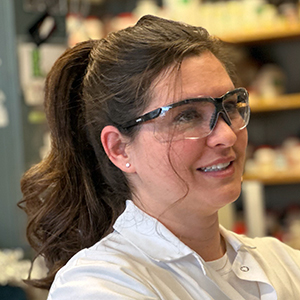An innovative graphene-based film helps shield people from disease-carrying mosquitoes, according to a new study funded by NIEHS. The research, conducted by the Brown University Superfund Research Center, was published Aug. 26 in the Proceedings of the National Academy of Sciences.
“These findings could lead to new protective methods against mosquitoes, without the environmental or human health effects of other chemical-based repellants,” said Heather Henry, Ph.D., a health scientist administrator with the NIEHS Superfund Research Program.
Mosquitoes threaten public health by carrying infectious viruses such as Yellow Fever, West Nile, and Zika, leading to disability and death for millions of people every year.
 Graphene, applied to the skin or incorporated into smart materials, could one day provide an alternative way to repel mosquitoes.
Graphene, applied to the skin or incorporated into smart materials, could one day provide an alternative way to repel mosquitoes.A new solution for an age-old problem
Results show that graphene, a tight, honeycomb lattice of carbon, could be an alternative to chemicals now used in mosquito repellants and protective clothing.
 Hurt leads the Laboratory for Environmental and Health Nanoscience at Brown. (Photo courtesy of Robert Hurt)
Hurt leads the Laboratory for Environmental and Health Nanoscience at Brown. (Photo courtesy of Robert Hurt)“We set out imagining that graphene film would act as a mechanical barrier — ultrathin but strong — but after observing the mosquito behavior, we began to suspect they were not interested in biting,” said Robert Hurt, Ph.D., director of the Superfund Research Program at Brown University.
Researchers found dry graphene film seemed to interfere with mosquitoes’ ability to sense skin and sweat because they did not land and try to bite. A closer look at videos taken of the mosquitoes in action revealed that the insects landed much less frequently on graphene than on bare skin.
The graphene film also provided a strong barrier that mosquitoes could not bite through, although when wet with sweat, mosquitoes landed on skin.
“This innovation using graphene to repel mosquitoes could help reduce the burden of ill health associated with a number of infectious diseases and might reduce the need for pesticides to eradicate the mosquitoes that carry them,” said William Suk, Ph.D., director of the NIEHS Superfund Research Program. “New material such as this one should be assessed in the field to determine full public health implications.”
 Graphene, shown in an artistic rendering, is incredibly thin and invisible to the naked eye, yet harder than diamonds, stronger than steel, and a better conductor of electricity than copper.
Graphene, shown in an artistic rendering, is incredibly thin and invisible to the naked eye, yet harder than diamonds, stronger than steel, and a better conductor of electricity than copper.Previous research led to current findings
Several years ago, Hurt began devising suits with graphene to protect workers against hazardous chemicals at environmental cleanup sites. He pointed out a wealth of literature demonstrates graphene’s impermeable qualities. Graphene is invisible to the unaided eye, yet harder than diamonds, stronger than steel, and more conductive than copper. Discovered in 2004, graphene now serves a variety of barrier and filtration purposes.
“The Brown University Superfund Research Center investigates innovative materials that could be barriers to hazardous substances in order to reduce human exposures to those substances,” Henry added. “This exciting project is one of several in a grant focused on developing materials for long-term environmental and health safety.”
Suk was pleased to see that this new use for graphene was developed as an offshoot of his program’s work. “SRP is a problem-solving program,” said Suk. “This is a significant public health problem that is in need of a solution.”
Citation: Castilho CJ, Li D, Liu M, Liu Y, Gao H, Hurt RH. 2019. Mosquito bite prevention through graphene barrier layers. PNAS; doi:10.1073/pnas.1906612116 [Online 26 August 2019].
(Carol Kelly is managing editor for the NIEHS Office of Communications and Public Liaison and Marla Broadfoot, Ph.D., is a contract writer for the same office.)









